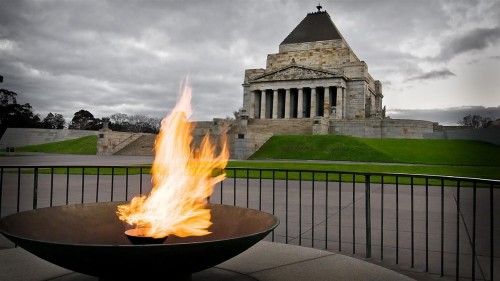SimplySwim
SimplySwim is a school management solution that helps swimming school owners and managers optimize operations by automating functions such as managing class schedules, billing and…
read more
The inclusion of 'technologies of remembrance' in public war memorials places visitors as witnesses of conflict, allowing them to create their own perceptions of war and peace-time, according to a Deakin University cultural heritage and museum studies researcher.
Public war memorials are closely held as solemn places for personal and collective commemoration and remembrance. However, in what some might see as a contentious move, this role is evolving with sites like Melbourne’s Shrine of Remembrance becoming places that also ‘teach memory’ and encourage critical discussion about peace and war.
Dr Steven Cooke, a researcher with Deakin University’s Faculty of Arts and Education and Alfred Deakin Institute for Citizenship and Globalisation, explained “with all sites of remembrance there is a tension and a need to strike a balance in the relationship between commemoration, education and tourism as well as helping people to learn about sacrifice, war and peace-keeping.
“However, interaction between the digital and the architecture of the Shrine as ‘technologies of remembrance’ has resulted in a novel way to teach memory, allowing visitors to ‘witness’ and actively participate in the ongoing work of memory and creating spaces for critique.”
Dr Cooke has been working with University of Melbourne’s Professor Hannah Lewi to investigate how the introduction of digital formats are reframing collective remembrance, commemoration and storytelling in the recently redeveloped Shrine of Remembrance in Melbourne.
Between 2001 and 2014 the Shrine was redeveloped with new exhibition spaces – the Galleries of Remembrance – which include interactive digital interpretation, and screen-based displays, as well as mobile apps to explore the Shrine and wider commemorative landscape.
The researchers found that the redevelopment allowed visitors to use the architectural components of the building and the digital interpretation to critique the conflicts that had taken place.

Professor Lewi added “people tend to see architecture and the use of digital technologies as separate and focus on digital interpretations but not look how the architecture, the internal geography of the building and the digital additions relate.
“You can see at the Shrine that the physical architecture of the monument, the new additions and the new digital content coalesce.
“They teach memory but they also create a more sensory and evocative experience and by doing so create ‘a witness’ through a personal engagement with the past.”
This shift to teaching and critique was consistent with moves by memorial museums around the world to look critically at their role in contemporary societies, Dr Cooke explained.
He added “not only are they there to commemorate those who had fallen in conflict but they are also asking should they act as international sites of conscience like the Slavery Museum in Liverpool and Hiroshima Museum in Japan?.
“Much of our war narrative has focussed on nationalism, patriotism, the story of the returning soldier or the soldier who did not return.
“The Shrine and other memorial sites are a place where that perspective can and should be told, but as the lines blur between the physical and digital worlds the visitor is being asked to bear witness to what has happened. This allows a different engagement with these issues: rather than a space for the inculcation of supposed national values, we can see the Shrine as a space for debate and critique.”
Images: Melbourne’s Shrine of Remembrance (top) and its museum (below).
12th April 2017 - JUNK FOOD CONSTITUTES MAJORITY OF PURCHASES FROM SWIMMING POOL KIOSKS
10th April 2017 - PUKEAHU NATIONAL WAR MEMORIAL PARK WINS LANDSCAPE ARCHITECTURE AWARDS
19th November 2016 - CENTRAL MELBOURNE’S TREES NEED TO ADAPT TO CLIMATE CHANGE
1st July 2016 - AUCKLAND MUSEUM MARKS DIGITAL MILESTONE
Support our industry news service
We hope that you value the news that we publish so while you're here can we ask for your support?
As an independent publisher, we need reader support for our industry news gathering so ask that - if you don't already do so - you back us by subscribing to the printed Australasian Leisure Management magazine and/or our online news.
The Complete Guide to Leisure Industry Products & Services.
SimplySwim is a school management solution that helps swimming school owners and managers optimize operations by automating functions such as managing class schedules, billing and…
read moreTurnstile Entry Systems and Access Control Centaman Entrance Controls’ Award Winning Range of Access Control Systems includes tripod & triarm turnstiles, speedgates, full height…
read moreDAE Global is one of the world’s leading international creative and production practitioners, creating award-winning sport, culture and entertainment experiences for over 30 years. It was…
read morePerfect Gym Solutions is a software as a service (SaaS) solution purpose-built to service the fitness industry, with over 1000 clients servicing over two million gym members across 40 countries making…
read moreExerp is a global IT specialist in member management software for the fitness and leisure industry. By focusing on the needs of large enterprises, where streamlining, control and scalability are…
read moreGianni Mattoli Director 0412 360 378 E: gianni@mattoli.com.au E: marketing@mattioli.com.au Tony Aloi National Operations Manager 0425 762 864 E: tony@mattoli.com.au MEL · SYD · ADE…
read moreAflex Inflatables are the leaders for obstacle courses, pool toys, waterparks and land-based watersides and fitness runs. They are industry leaders offering the widest range of pool, lake and beach…
read moreGet your business noticed in our targeted directory. Viewed by 10,000 industry professionals per week!